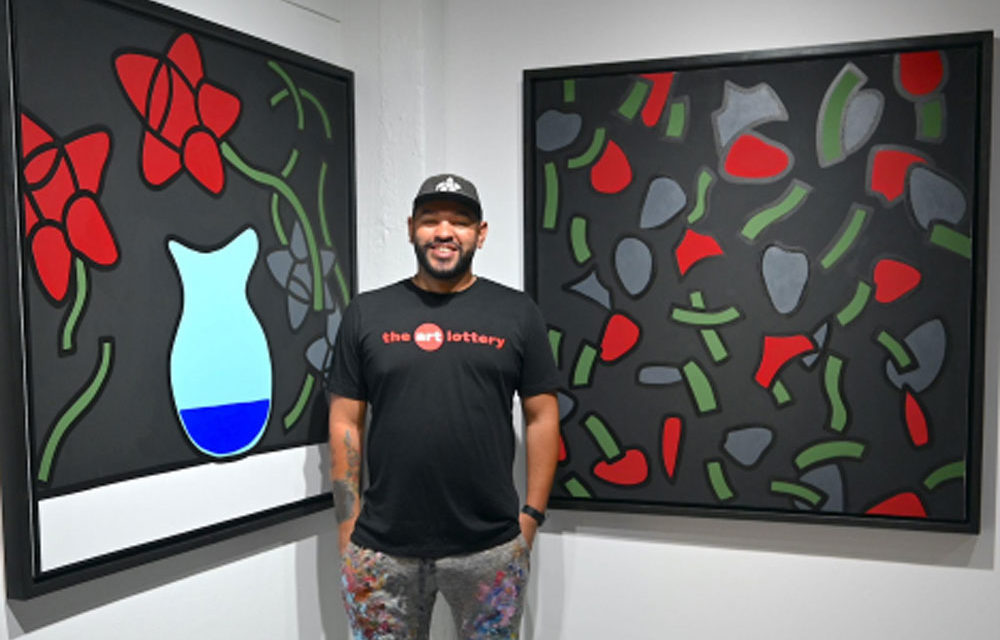The day that Albert Gonzales quit his job to devote himself full time to creating art was also the day he decided that he would become an artist completely on his own. At age 24 he had tired of the daily routine of processing and determining insurance coverage for a CVS pharmacist unit. He also believed that creativity and sacrifice complemented each other.
He moved out of his family home with the thought that in a few weeks or months, he would earn enough as an artist to get his own apartment and studio. A year later he was still sitting all night at his favorite I-Hop, drawing and surviving on five dollars or less a day. During the day he rode the bus in search of busy tourist areas where he could sell street art. He carried his paints and clothing in a suitcase that never left his side.
One day on the way to the bus stop he spotted a broken table top in a dumpster near some apartments. He took the table top on the bus and stopped to buy new oils and brushes. He was on Main Street painting the oak table top when a woman appeared and accepted his $75 price for his nearly completed painting. That was the day he began believing that his art would one day belong in an art gallery.
A fellow street artist suggested that Gonzales consider taking evening art classes at Southwest School of the Arts. Primarily a self-taught artist, Gonzales enrolled in a class taught by Daniel Rodriguez at the art school. While at the Southwest School he met Alejandro Sifuentes, who offered Gonzales an apprenticeship. Gonzales’ art was selling well enough that he began considering his own studio space.
Gonzales’ search for a place to work took him to the Hausman Millhouse Studios west of San Pedro Park. The
Hausman family rented studio spaces in a renovated warehouse where artist Rex Hausman painted on a daily basis. Gonzales met many other artists at the Millhouse, and his knowledge of producing and selling art increased significantly. I met Gonzales through the Millhouse Studios and over the next year I helped him sell dozens of his paintings, buying several for myself and introducing him to other buyers. In time, Gonzales moved to his own space at 1913 South Flores.
In his first year at the Millhouse, Gonzales met his future wife and fellow artist Caroline Adam. Together they sold enough art to travel to Philadelphia and New York City for an art educational tour. The Barnes Museum is famous for its vast holdings of impressionist paintings, but it was the work of Henri Matisse that completely overwhelmed Gonzales. Matisse’s paintings of flowers in vases became a transformational inspiration for Gonzales.
Upon his return from Philadelphia Gonzales had “a dream that color cut outs were floating down onto a canvas.“ What resulted was his “Wabi Sabi” a creation of flowers in a vase that appeared like cut outs. Over the next two years Gonzales sold more than 400 paintings of his “Wabi Sabi” flowers series. He describes “Wabi Sabi” as a Japanese philosophy that can be translated to the idea of embracing the beauty of the imperfect, or in simple terms, perfectly imperfect.
Most San Antonio art galleries were closed during the months of the 2020 pandemic. Sales were noticeably down, but Gonzales, like many of his peers, sold occasionally through the internet. In early summer of 2021 Gonzales was invited to show in several exhibits in the city. He had a solo show at the Upstairs Studios, a small gallery at the Blue Star Art Complex. A large pink Wabi Sabi painting was featured in early July at the AnaArt Gallery on Broadway and Sunset.
His works in both of these galleries largely represent flowers floating in a transparent vase, and he explained that he uses “water to tell a story of life by keeping the water in the vase in a constant fluid motion even though the vase is on a flat plane.” One of these interpretations is in his example, “We all have our ups and downs in life.”
He considers his art as a visual interpretation of that Japanese philosophy where he creates what he explained as “non-anatomically correct flowers to stand as a symbol meaning we are the flower. We all have our own imperfections or insecurities.” In the Upstairs Gallery, Gonzales displayed one large painting with broken stems, an acknowledgment that life is often complicated by a loss of connection, a time when the flower may no longer be whole.
Gonzales will be one of the featured Westside Latino artists at an exhibition on September 24th commemorating the relocation of the Say Si! Art education center to the Westside of the city. Located in a 100,000 square foot renovated warehouse on Brazos
Street, Say Si! offers free art classes for 200 middle and high school students from all over the city.
A Westside native, Gonzales has produced many large paintings with his signature bold colors. His work stands as an example showing that artists with strong perseverance, with a willingness to experiment, and with resolve to dedicate themselves to constant improvement have a chance to succeed.
( 1 & 3 Gonzales at the Upstairs Studios. Blue Star Art complex. Photo by Ricardo Romo, 2021
2 Street artist Albert Gonzales found work early in his career painting murals for small business owners. The Pig Stand on Presa Street. Photo by Ricardo Romo 2019.)
A Former Latino Street Artist Sells in Galleries









